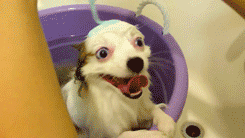UPDATE: I have seen a lot of joking around on Pinterest about the faces in my Before and After pictures. This is making me laugh because it was completely unintentional--I am a HORRIBLE auto-timer picture taker, and these were the best ones I ended up with. I also have no control over when I do the smoulder. It's a disease. I love how many of you are enjoying and using this pattern!
Hello lovelies! I'm sitting down to my lunch of cherries, fresh-picked snow peas, and barbecue Kettle chips. Last time I did a T-shirt remodel for Pinterest it was a hit, but alas, I failed to do a tutorial. This time around, I have learned my lesson. Re-making a t-shirt is the most forgivable sewing project I've encountered as of yet--surprising for it being stretch fabric! Just remember: nothing has to be perfect, scissors are your best friend, and raw edges are cool.
You will need:
-a T-shirt that is significantly too big for you (I usually wear a small or x-small, sometimes a medium--the shirt I used was either a large or x-large), either men's or women's.
-Access to a sewing machine and similar color thread to the shirt
-Lots and lots of straight pins (light bulb! Safety pins would work amazing for this project too.)
-Waxed dental floss
-Embroidery needle
-Mirror
Here is a horrible picture of what it started out looking like:
Step 1: Remove the sleeves. Cut off the sleeve and the seam that attaches the sleeve to the rest of the shirt. Your shirt will now look like a strange tank top for men to work out in.
Step 2: Turn the shirt inside out and try it on. (It will look like a horrid smock. Don't worry!) Bring your pins with you to a mirror, and pin along your wonderful curves until the outline is the way you want it. I used straight pins, but they do fall out sometimes when you remove the shirt to sew. I highly recommend trying safety pins for this step!
Put the first pins on either side of your natural waist, which is the narrowest point on your torso. This will help guide the rest of your pins and keep the sides even. Once you're done, it should look like this:
Imagine it 90 degrees clockwise. Technology is hormonal today.
Step 3: Remove the shirt (good luck!) and fix the pins so that nothing is super lumpy or misshapen. By no means does this have to look perfect, but we don't want any puckers while sewing or odd bulges when the shirt is done.
Step 4: Sew along the pins. Since the material is stretchy I went with the longest stitch my machine would allow. Don't forget to backstitch! Do your best to line up the bottom hems, but as long as they're close it isn't a big deal. If they are too far off but the rest looks good, just cut off the entire bottom hem all around and call it good ;) See what I told you about forgivable?
Step 5: Try on the shirt right-side out to make sure nothing is funky. (I had to fix the upper part so that the sleeve holes were smaller.) If anything is weird, re-do all or part of the seam where it needs help. Remember that we're not done yet!
Step 6: Once you're happy with the shape of your shirt, cut off the excess inside. Make sure to leave some extra seam allowance--we'll need it in the next step.
Step 7: Begin the ruching! Decide how far up from the bottom you want your gathers to go. I put mine up to just under my natural waist, but the decision is yours. Put a pin where you want your ruching to stop.
Step 8: Cut a long piece of dental floss, two or three times the length of the section to be ruched. Go to your sewing machine and zigzag stitch the floss onto the extra seam allowance of the bottom part of the shirt (the zigzag stitching acts as a kind of casing for the floss--do not sew into the floss! It needs to be able to move!). Here's what it should look like:
And at the ends:
Step 9: Thread the bottom end of the floss onto an embroidery needle and tack it down. Do several stitches to make sure the floss is firmly in place, then tie it off well.
Step 10: Take the top end of the floss and pull on it, working with the material to gather it. Gather it as much as you like--I pulled it as much as it would easily go without making it overly bunchy or putting strain on the floss, then flattened the last inch or two. Once you are satisfied, thread that end of floss onto your needle and use several stitches to tack down the floss. Even out the gathers and begin tacking those, working your way down to the bottom. Once that's done, do some more tacking stitches and then tie off. Here is a blurry and sideways picture:
Repeat steps 7-10 on the other side. Turn right side out, and you're done!
I hope you have enjoyed my technology-tantrum tutorial. Let me know if you have any questions or suggestions for other things I can do tutorials of :) Have a lovely day.
Blessings,
Hannah =)













.jpg)
















